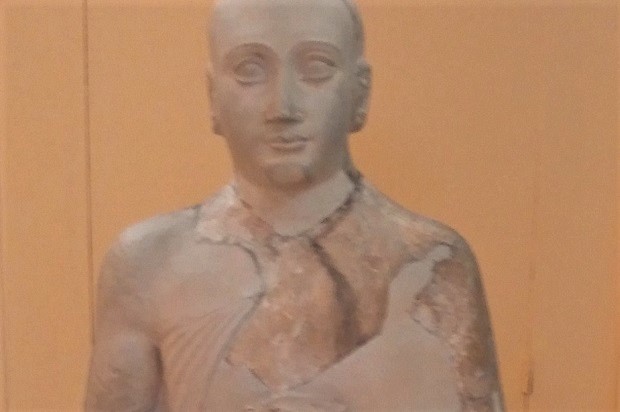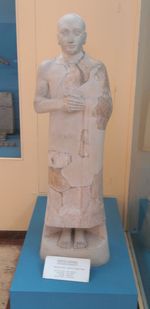Gudea of Lagash: A contemporary of Melchizedek
In Jesus Christ, we have the perfect fulfillment of the idealized Sumerian vision of the Shepherd King that Gudea and other kings sought to achieve in their lifetime.
02 JANUARY 2018 · 12:48 CET

Gudea was king of the Sumerian city-state of Lagash around the 22nd century BCE. After 200 years of servitude to Akkadian overlords, the Sumerians gained a measure of freedom when northern tribes called the Gutians started raiding the Akkadians.
It is in this window of opportunity that Gudea ruled. Sumer was politically in a decline, but this period is dubbed by some as the golden age for the Sumerian arts because of the artifacts of great artistic quality that have been discovered.
Gudea was known to be a Shepherd King. The title Shepherd King was often used by Sumerian rulers as a way to distinguish themselves from neighboring cultures. In Egypt, for example, the king was regarded as a god. Such kings would lord over their subjects.
In Sumer, however, kings tended to depict themselves as servants of the people. Shepherds tend to the flock and protect them from predators. As such, the rulers in Sumer saw themselves as herders of men.
The ruler would take care of his subjects and protect them. In return, the subjects would willingly give their allegiance to their ruler.
Gudea, however, took this concept a step further. He refused the title of Lugal (king) and instead adopted the title of Ensi (governor). The Ensi was subservient to the Lugal.
Given that Gudea was the highest man in power, some believe that he chose the title Ensi because he saw himself not as a King but as a servant of the god Ningirsu; a god of law, farming, and hunting.
Many inscriptions have been discovered where Gudea details construction projects including numerous temples to this diety. Gudea was concerned for issues of social justice and the social welfare of his people.
Both in the steles and the statues that have remained, it is interesting to note that Gudea resembles a priest more than he does a king. The garments he wears, the bald head and clean-shaven face, point to characteristics more common to priests than kings. We can see in Gudea how the role of high priest and king was merged into one.
We also know that during this period Gudea had an active trade life with the Mediterranean coast; specifically, the regions encompassing modern Syria, Lebanon, and Israel. Much of the cedar wood and stone used in his construction projects were brought from this area.
By now, you may be realizing where this is going. There are some unavoidable similarities in play between the Biblical Melchizedek and Gudea of Lagash.

Perhaps Melchizedek saw himself as an Ensi of El Elyon, the most high God. At the very least this is what the narrator of Genesis seemed to recognize in this person: “He was priest of God Most High.” (Gen 14:18, ESV).
I don’t think it wouldn’t be too far-fetched to suggest some bridge between ancient Sumer and Melchizedek’s Jerusalem. The name of the city of Jerusalem suggests Sumerian connections.
Urusalim is the form in which this city name appears in the Amarna letters of Abdi-Heba (1330’s BCE). Some have suggested the etymological origin of Ur-Salim would be a composite of the Ugaritic word for city (Ur) and the Sumerian word for the god of dusk (Shalim).
Dusk is the time of day when the day draws to a completion; perhaps this is the root of the concept of peace (Shalom).
Biblically speaking a connection between Canaan and Sumer is also not too far-fetched. Abraham and his family migrated from Ur of the Chaldeans to Canaan. It’s possible that there was some sort of affinity between Abraham and Melchizedek, king of Ur-Shalim.
This would perhaps explain Melchizedek’s willingness to assist Abraham’s men after they rescued Lot in a conflict with local Canaanite rulers.
Following the rescue of Lot, Melchizedek offered bread and wine to Abraham’s men and blessed them with a prayer. Abraham thanked Melchizedek for his assistance by giving him a tenth of the loot he had obtained in Lot’s rescue mission.
Both Melchizedek and Abraham seemed to have grasped the idea that there was one creator God. Both understood that they were serving Him.
In Psalm 110 David recognizes that the coming Messiah would be in the order of Melchizedek. In other words, the Messiah would fulfill both the role of king and high priest.
In the New Testament, the author of Hebrews uses the figure of Melchizedek masterfully as a typology of Jesus Christ. Jesus Christ is both high priest and king. Jesus is the true King of Righteousness.
Abraham, the father of the Hebrews, recognized the spiritual authority of Melchizedek by giving him a tithe. By being in the “order of Melchizedek,” the spiritual authority of Jesus is superior not only to that of Abraham, but also to that of the Jewish high priests or Levites as found in the Law of Moses.
In Jesus Christ, we have the perfect fulfillment of the idealized Sumerian vision of the Shepherd King that Gudea and other kings sought to achieve in their lifetime.
Jesus is the perfect high priest and king who does not brutally lord over his subjects but works on behalf of their welfare. He is a king who gains the loyalty and allegiance of his subjects not through force or terror but through his acts of mercy.
Marc Madrigal is a member of the Istanbul Protestant Church Foundation in Turkey.
BIBLIOGRAPHY
The Sumerian Shepherd Kings.
Nicol, Thomas Rev. The Coral Lectures for 1898: Recent Archaeology and the Bible. William Blackwood and Sons. Edinburg and London, 1899. p.102-104
Published in: Evangelical Focus - Archaeological Perspectives - Gudea of Lagash: A contemporary of Melchizedek
